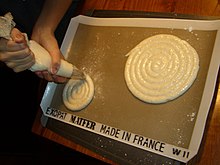
Back كيس حلواني Arabic Кандытарскі мяшок Byelorussian Mànega de pastisseria Catalan Spritzbeutel German Manga pastelera Spanish Gozogintzako mahuka Basque ماسوره و قیف قنادی Persian Poche à douille French שקית זילוף HE Kantong pengacu ID


A pastry bag (or piping bag in the Commonwealth) is an often cone- or triangular-shaped bag made from cloth, paper, plastic, or the intestinal lining of a lamb, that is squeezed by hand[1] to pipe semi-solid foods by pressing them through a narrow opening at one end often fitted with a shaped nozzle, for many purposes including in particular cake decoration and icing. It is filled through a wider opening at the opposite end, rolled or twisted closed, and then squeezed to extrude its contents. Many differently shaped nozzles are used to produce cross-sections such as star, leaf, and flower-petal shapes; a simple circular nozzle makes round shapes and is also used for filling pastries such as profiteroles.
In addition to icing, pastry bags are commonly used to shape meringue and whipped cream, and to fill doughnuts with jelly or custard. They are used to form cream puffs, éclairs, and ladyfingers. Bags can also be used to shape savory foods such as filling for deviled eggs, whipped butter, and mashed potatoes (especially for Pommes duchesse).
Reusable bags are usually made from tightly woven nylon, polyester, rubber or waterproofed (plastic-coated) cotton.[2][3] After use they are washed and hung to dry. A high-quality bag may last for many years.
Disposable bags do not require washing;[4] they are typically made of inexpensive plastic. A plastic food storage bag may be used as a pastry bag. For small quantities and fine piping, a pastry bag can be made by rolling cooking parchment or wax paper into a cone, filling it, folding the wide end several times to close it, and then cutting the tip into whatever shape is desired. This is especially useful for small quantities of melted chocolate, since a very small hole can be cut and the bag can be discarded when it cools and becomes clogged.
Interchangeable tips usually come in sets;[5] particular tips can often be purchased individually. They may be chrome-plated or stainless steel, or plastic. Each tip is cone-shaped, with a base too large to fit through the small opening in the bag; in some cases they are inserted through the larger opening before food is spooned in. If tips need to be interchanged without emptying the bag, they can be used with pairs of adapter rings: an inner ring is dropped inside the bag and pushed part way out the hole, a tip is slipped over the ring, then an outer ring is slipped over the tip and screwed onto the inner ring. Some inexpensive sets are of disposable plastic film with a drop-in ring and screw-on plastic tips (see image above). Many foods (including frosting and pressurized "spray can" whipped cream) can be purchased in disposable packaging designed to serve the function of a pastry bag.
- ^ Feuer, Janice (1993). Fruit-sweet and sugar-free: prize-winning pies, cakes, pastries, muffins & breads from the Ranch Kitchen Bakery. Rochester, Vt.: Healing Arts Press. p. 138. ISBN 9780892814497. Retrieved 20 August 2014.
- ^ Maxfield, Jaynie (2003). Cake decorating for the first time. New York: Sterling Pub. p. 15. ISBN 9781402717239. Retrieved 20 August 2014.
- ^ Poulos, Barbara Fairchild; photography by Con (2010). Bon appétit desserts the cookbook for all things sweet and wonderful. Kansas City, Mo.: Andrews McMeel Pub. p. 23. ISBN 9781449402006. Retrieved 20 August 2014.
{{cite book}}: CS1 maint: multiple names: authors list (link) - ^ Ruhlman, Michael (2007). The Elements of Cooking: Translating the Chef's Craft for Every Kitchen. Simon and Schuster. p. 241. ISBN 9781416579229. Retrieved 20 August 2014.
- ^ Valastro, Buddy (2011). Baking with the Cake Boss. Simon and Schuster. p. 19. ISBN 9781451628913. Retrieved 20 August 2014.